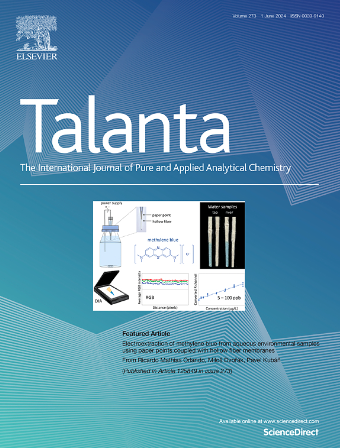用于高灵敏可视检测淡水鱼体内盐酸四环素的柔性银金属有机框架探针
IF 5.6
1区 化学
Q1 CHEMISTRY, ANALYTICAL
引用次数: 0
摘要
盐酸盐四环素是水产养殖中常用的预防细菌感染的药物,其残留检测对确保水产品安全至关重要。本研究通过水热法合成了ag基金属有机骨架Ag-dcp (H3dcp = 3-(3,5-二羧基苯基)-6-羧基吡啶)。Ag-dcp框架具有环境优势,包括绿色合成过程和可持续、环保应用的潜力。Ag-dcp中的非配位羧基为TCH提供了潜在的相互作用位点,而Ag-dcp灵活结构中的菱形通道与TCH的大小相匹配,有效地促进了主-客体相互作用。Ag-dcp通过由tch诱导的醚键旋转触发的分子内电荷转移(ICT),实现了高灵敏度的比例荧光检测。该探针的荧光颜色由蓝色变为橙色,检测限低至0.14 μM,响应时间仅为10 s。采用主成分分析(PCA)有效区分TCH与其他四环素类似物(盐酸米诺环素(MH)和盐酸多西环素(DOX)),从而提高Ag-dcp探针的选择性。荧光探针检测淡水鱼中TCH的性能与HPLC相当。本文提出的基于MOF结构的检测策略,为MOF材料的设计及其专业应用提供了有价值的见解。本文章由计算机程序翻译,如有差异,请以英文原文为准。

Flexible silver-metal-organic framework probe for highly sensitive and visual detection of tetracycline hydrochloride in freshwater fish
Tetracycline hydrochloride (TCH) is commonly used in aquaculture to prevent bacterial infections, renders the detection of its residues highly crucial for ensuring the safety of aquatic products. In this study, an Ag-based metal-organic framework, Ag-dcp (H3dcp = 3-(3,5-dicarboxyphenyl)-6-carboxypyridine), was synthesized through hydrothermal method. The Ag-dcp framework offers environmental advantages, including a green synthesis process and potential for sustainable, eco-friendly applications. The uncoordinated carboxyl groups in Ag-dcp provide potential interaction sites for TCH, while the rhombic channels in the flexible structure of Ag-dcp that match the size of TCH effectively facilitate host-guest interactions. The Ag-dcp enables ratiometric fluorescence detection with high sensitivity via intramolecular charge transfer (ICT) triggered by TCH-induced ether bond rotation. The probe demonstrates a fluorescence color changes from blue to orange, achieving a detection limit as low as 0.14 μM and offering an ultrafast response time of just 10 s. Principal component analysis (PCA) was employed to effectively distinguish TCH from other tetracycline analogs (minocycline hydrochloride (MH) and doxycycline hydrochloride (DOX)), thereby enhancing the selectivity of the Ag-dcp probe. The fluorescence probe demonstrated performance comparable to HPLC in detecting TCH in freshwater fish. The detection strategy proposed here, based on the MOF structure, offers valuable insights for designing MOF materials and their specialized applications.
求助全文
通过发布文献求助,成功后即可免费获取论文全文。
去求助
来源期刊

Talanta
化学-分析化学
CiteScore
12.30
自引率
4.90%
发文量
861
审稿时长
29 days
期刊介绍:
Talanta provides a forum for the publication of original research papers, short communications, and critical reviews in all branches of pure and applied analytical chemistry. Papers are evaluated based on established guidelines, including the fundamental nature of the study, scientific novelty, substantial improvement or advantage over existing technology or methods, and demonstrated analytical applicability. Original research papers on fundamental studies, and on novel sensor and instrumentation developments, are encouraged. Novel or improved applications in areas such as clinical and biological chemistry, environmental analysis, geochemistry, materials science and engineering, and analytical platforms for omics development are welcome.
Analytical performance of methods should be determined, including interference and matrix effects, and methods should be validated by comparison with a standard method, or analysis of a certified reference material. Simple spiking recoveries may not be sufficient. The developed method should especially comprise information on selectivity, sensitivity, detection limits, accuracy, and reliability. However, applying official validation or robustness studies to a routine method or technique does not necessarily constitute novelty. Proper statistical treatment of the data should be provided. Relevant literature should be cited, including related publications by the authors, and authors should discuss how their proposed methodology compares with previously reported methods.
 求助内容:
求助内容: 应助结果提醒方式:
应助结果提醒方式:


